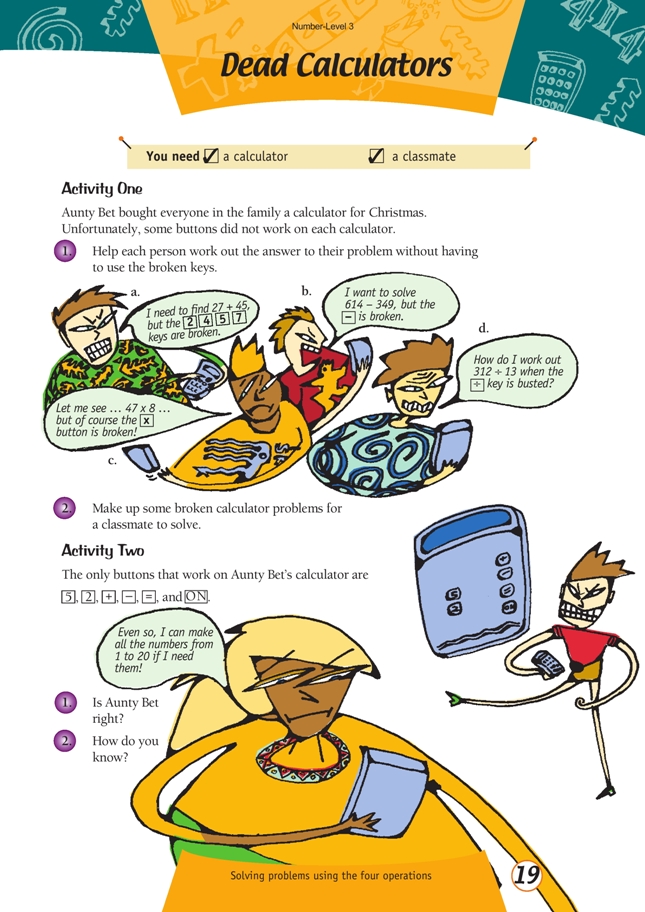This is a level 3 number activity from the Figure It Out series. It relates to Stage 6 of the Number Framework.
A PDF of the student activity is included.
Click on the image to enlarge it. Click again to close. Download PDF (160 KB)
solve problems using multiplication, division, addition, subtraction operations on a calculator
FIO, Level 3, Number, Book 1, Dead Calculators, page 19
A classmate
Activity One
This activity encourages students to use problem-solving strategies with the four operations and whole numbers.
Question 1a is more open-ended than the others because it is the digits that cannot be used rather than the operations. Encourage students to find as many ways as possible of solving this particular question. Suggest that they may wish to combine operations, including multiplication and division, for example, 30 – 3 + 63 – 18 or (3 x 9) + (5 x 9) – 9. To do this on a basic calculator, students may need to use the memory keys because the calculator will not have brackets. Students could see
whether their calculator can do this:
Students who use mental strategies may come up with 8 x 9 = because they recognise that 27 is 3 nines and 45 is 5 nines, so 27 + 45 must be 8 nines.
Activity Two
This is a good problem-solving activity. You may wish to ease students into it by suggesting that they start by only making the numbers from 1 to 5. Check that students are being systematic.
Recording their results in sequence from 1 to 5 is one systematic approach.
Another approach is to find the easy ones first. This way, you will soon see which students have not got the idea of combining a number of twos or a number of fives as well as making combinations of twos with fives.
Extend this activity with questions such as:
“Try two other numbers besides 2 and 5 with the addition and subtraction keys.”
“Could we make all the totals from 1 to 20 using two even numbers?”
“Try to solve the problem using the multiplication key as well.”
Answers to Activities
Activity One
1. Answers will vary. They could include:
a. (10 + 10 + 6 + 1) + (10 + 30 + 3+ 1 + 1) = 72, or 30 – 3 + 63 – 18 = 72,
or (3 x 9) + (6 x 9 – 9) = 72
b. 349 + 1 = 350
350 + 250 = 600
600 + 14 = 614
So, 614 – 349 = 1 + 250 + 14
= 265
c. 47 + 47 + 47 + 47 + 47 + 47 + 47 + 47 = 376
d. 312 – 13 – 13 – 13 … until the answer is 0, and count the number of times you have subtracted 13 (24) or use the constant function (312 – 13 = = = =)
2. Answers will vary.
Activity Two
1. Yes
2. Some ways of making each number are:
1 = 5 – 2 – 2
2
3 = 5 – 2
4 = 2 + 2
5
6 = 2 + 2 + 2
7 = 5 + 2
8 = 5 + 5 – 2
9 = 5 + 2 + 2
10 = 5 + 5
11 = 5 + 2 + 2 + 2
12 = 5 + 5 + 2
13 = 5 + 5 + 5 – 2
14 = 5 + 5 + 2 + 2
15 = 5 + 5 + 5
16 = 5 + 5 + 2 + 2 + 2
17 = 5 + 5 + 5 + 2
18 = 5 + 5 + 5 + 5 – 2
19 = 5 + 5 + 5 + 2 + 2
20 = 5 + 5 + 5 + 5
